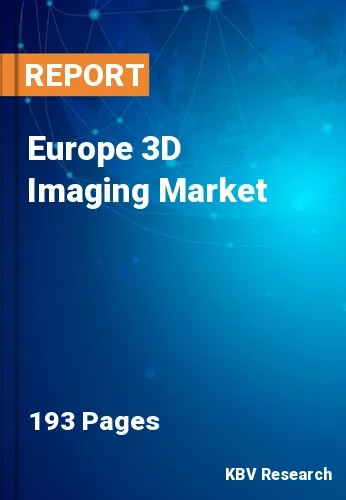The Europe 3D Imaging Market would witness market growth of 18.8% CAGR during the forecast period (2023-2030).
The surge in augmented reality (AR) and virtual reality (VR) applications has contributed to the adoption of 3D imaging. These immersive technologies use accurate 3D models to create realistic and interactive virtual environments. As AR and VR gain traction across industries, so does the demand for high-quality imaging. The adoption of additive manufacturing, commonly known as 3D printing, has propelled the use of 3D. Designing intricate and complex structures for 3D printing requires precise 3D models. Industries such as aerospace, automotive, and healthcare leverage it to create detailed prototypes and customized components, fostering the growth of the additive manufacturing.
The convergence of 3D with other emerging technologies, like artificial intelligence (AI) and machine learning, amplifies its capabilities. AI algorithms can analyze and interpret 3D imaging data more efficiently, enhancing decision-making processes. This synergy of technologies encourages organizations to integrate 3D into their broader digital transformation strategies. Including CT scans, MRI, and ultrasound, provides detailed and accurate representations of anatomical structures, aiding healthcare professionals in diagnosing and treating medical conditions. Surgeons use 3D for precise pre-operative planning, allowing them to visualize complex structures and optimize their surgical approach. Its data is utilized in 3D printing for creating patient-specific models, implants, and prosthetics.
According to the UK Government, with its highly linked supply chains and substantial demand for UK-built cars throughout the region, the European region has benefited the U.K. automotive sector with its varied products, encompassing volume, premium, and niche vehicles. E-commerce platforms can utilize 3D-imaging for interactive product customization in Spain. According to the International Trade Administration, the number of e-commerce consumers in Spain reached 30 million in 2021. eCommerce penetration was estimated at 63%, and internet penetration at 83% in 2021. By 2025, there will be 37 million eCommerce users, a 25% increase. Hence, all these factors will uplift the regional market’s expansion in the coming years.
The Germany market dominated the Europe 3D Imaging Market by Country in 2022, and would continue to be a dominant market till 2030; thereby, achieving a market value of $7,746.2 million by 2030. The UK market is exhibiting a CAGR of 17.8% during (2023 - 2030). Additionally, The France market would experience a CAGR of 19.7% during (2023 - 2030).
Free Valuable Insights: The Global 3D Imaging Market will Hit $117.9 Billion by 2030, at a CAGR of 19.2%
Based on Component, the market is segmented into Hardware (3D Display, 3D Camera, 3D Scanner, Others), Software (3D Modeling Software, 3D Scanning Software, 3D Layout & Animation Software, 3D Visualization & Rendering Software, Image Reconstruction Software, Others), and Services. Based on Software Deployment Type, the market is segmented into On-premise, and Cloud. Based on countries, the market is segmented into Germany, UK, France, Russia, Spain, Italy, and Rest of Europe.
By Component
By Technology
By Vertical
By Country
Our team of dedicated experts can provide you with attractive expansion opportunities for your business.

